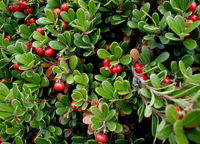
SCIENTIFIC NAME
Arctostaphylos uva-ursi
DESCRIPTION
Bearberry leaves are dark green and thick with smooth margins arranged alternatively on the stem; they remain on the bush year-round. Small clusters of white-pink flowers hang down from the tips of branches. This low-growing shrub slowly spreads to form mats, making it a useful groundcover for areas that are not suitable for a lawn or flower garden.
RANGE
This attractive and hardy plant is widespread in Canada, found in all provinces and territories and at various elevations, from sea level to sub-alpine.
HABITAT
It typically grows along sandy and rocky areas including shorelines, slopes, ridges, hilltops and in coniferous and mixed woods.
DIET
BEHAVIOUR
undefinedPRIMARY ECOSYSTEM ROLES
Bearberry is a great wildlife plant. It provides nectar, which has been known to attract butterflies and hummingbirds. Its leaves are eaten by many mammals including deer, elk, bighorn sheep and moose, and it acts as a larval food plant for some butterfly species. Bearberry fruit is eaten by birds such as thrushes, wrens, grouse, robins and waxwings. Other animals that use the fruit as a winter food source are bears, deer and small mammals.
 |
| Photo: Sten Porse |
By Sarah Coulber
I think it’s safe to say that Canadian gardeners appreciate plants that offer visual interest in more than one season. Pretty flowers in spring or summer followed by bright fruit in summer or fall are a satisfying combination. Add to that rich fall foliage and berries that can last through the winter, and you pretty much have a winner. Now, what if I told you that one such plant just happens to be native to most of Canada and is generally drought, wind, salt and heat resistant. What an exciting thought!
Meet Arctostaphylos uva-ursi, also known as common bearberry or, to the Aboriginals, as kinickinick (sometimes spelled “kinnikinnick”). This attractive and hardy plant is widespread in Canada, found in all provinces and territories and at various elevations, from sea level to sub-alpine. It typically grows along sandy and rocky areas including shorelines, slopes, ridges, hilltops and in coniferous and mixed woods.
Uses
The Aboriginal people of North America have traditionally used this plant as an ingredient in their smoke mix, hence the word “kinnikinnick,” which roughly means “smoking mixture.”
Bearberry leaves have also been used to make a strongly astringent tea that helps with kidney and bladder infections, and the tannin in leaves has helped with tanning hides.
Bearberry is also useful on slopes, helping to prevent erosion.
Caution: We are not recommending the use of these plants for medicinal or food purposes. Many plants are poisonous or harmful if eaten or used externally. The information on food and medicinal value is only added for interest. The accuracy of this information has not been tested.
Propagation and Care
If you wish to grow this plant on your property, give it sun to partial shade. It will do best in acidic sandy or rocky conditions. If your soil isn’t acidic, you can increase its acidity by adding some pine and oak trees to the side of your property where you hope to one day add bearberry. Let their leaves and needles remain on the ground rather than raking them up. They will slowly decompose, increasing the acidity in the top layers of your soil. You can also help matters by working them into the soil for the first few years.
Bearberry also has great potential for growing in rock gardens. Refrain from over fertilizing, as this can kill the plant. Water well for first year or two to help establish the plant in your garden.
Bearberry is supposed to be rather challenging to grow on your own, so this is one plant that is best to buy from the nursery. Check out our Native Plant Supplier List for one near you.
